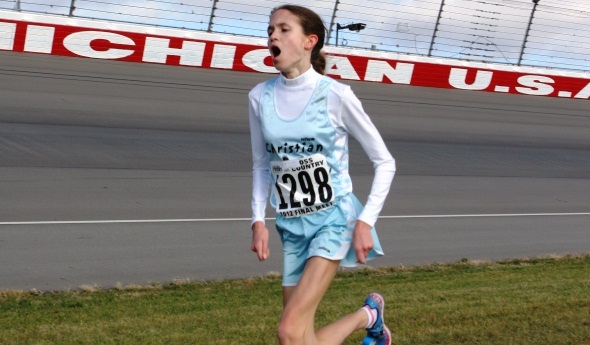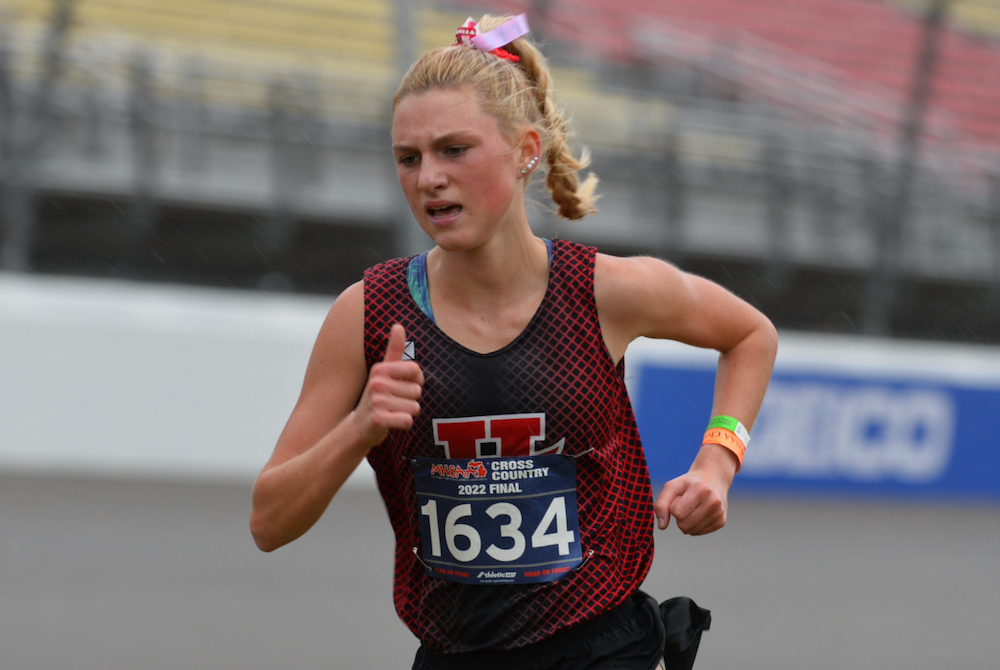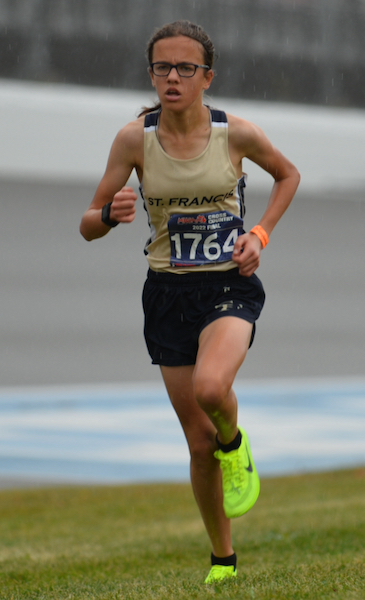
Bos Buzzes to Repeat as D2 Champion
November 3, 2012
By Bill Khan
Special to Second Half
BROOKLYN — Julia Bos of Grand Rapids Christian seems to answer more questions about the style of her running, rather than the substance.
Bos runs with her mouth wide open, something she has done ever since becoming a competitive runner.
“Have you ever swallowed a fly?” was a question posed to her Saturday at the MHSAA Lower Peninsula Division 2 meet at Michigan International Speedway.
“Once I caught a bumble bee this summer; it wasn’t very fun,” she said. “It stung me on the tongue. I spit it out right away. It was all fuzzy. I’m just thankful I’m not allergic to bees.”
Bos has a ready response to inquiries about her signature facial expression.
“People ask me why and I say, ‘Optimum oxygen absorption,’” she said. “I don’t really think about it consciously. I’m just going, ‘If I look silly, oh well, it works.’”
Indeed it does.
Bos repeated as the Division 2 champion with a time of 17:20.4, the second-fastest of the day in all four divisions. West Bloomfield’s Erin Finn won Division 1 in 17:07.9.
Bos, who was undefeated as a senior, bolted to the lead and was never threatened, winning by 28.7 seconds over Cedar Springs sophomore Kenzie Weiler. Bos reached the mile in 5:20, about five seconds faster than usual, as she wanted to dictate the terms of the race.
“I was aggressive early on in the race,” Bos said. “Last year, the first mile was really slow. Everybody in the front was trying to be tactical. We went out in 5:40 something. That was really slow for a state meet. This year, I tried not to think of the people by me and go at my own pace.”
Bos almost quit cross country before ever realizing her potential as a back-to-back MHSAA champion who will have her choice of major college programs at which to further her career. She said the pressure to succeed became too much until two years ago when she took fourth at MIS and led Grand Rapids Christian to the team title.
“I had kind of a revelation during my sophomore year,” she said. “I was basically trying to put all the pressure on myself and run for myself and be, ‘Oh, my word, I just always have to win,’” she said. “I would get so nervous during the school day if we had a meet after school; I could hardly take it. I almost quit the team, actually.”
Her coach and parents talked her out of it.
“I realized it’s so much more fulfilling to run for God and not for myself and not for other people’s expectations,” Bos continued. “I know that He will be happy with whatever I do, whether it’s a (personal record) or a slower day, as long as I do my best.”
Ada Forest Hills Eastern romped to the team championship by a 93-150 margin over Spring Lake. Grand Rapids Christian was third with 182 points, as Grand Rapids-area schools took five of the top six places.
Senior Ciara Cullen was fourth among team runners and sixth overall in 18:10.6 to lead Forest Hills Eastern, which had five runners cross before Spring Lake’s No. 4 runner.
Junior Mary Kostielney was 15th among team runners in 18:42.8, freshman Lauren Allard was 20th in 18:58.9, sophomore Abigail Bowman was 24th in 19:11.2 and senior Angela Ottenwess was 30th in 19:20.1 for Forest Hills Eastern.
PHOTO: Grand Rapids Christian senior Julia Bos puts the finishing strides on her second straight MHSAA Division 2 championship. (Click to see more from RunMichigan.com.)

Jazwinski Brings Hart Individual Title as St. Francis Moves to Front of Team Pack
November 5, 2022
BROOKLYN – Cross country races can be won between the ears before runners ever step foot onto the course.
Attitudes were tested as rain began to descend on Michigan International Speedway and the wind picked up just before the start of the MHSAA Lower Peninsula Division 3 girls race late Saturday morning.
Hart sophomore Jessica Jazwinski was loving life as she prepared to race.
“As a distance runner, I really try to love the wind,” she said. “Distance running and cross country is just a tough sport. The wind just adds to it — and the rain, too. It’s super fun.
“I was just thinking these conditions are just gonna feed my great race. This is real cross country. Yeah!”
Jazwinski overcame the elements to run the fifth-fastest Division 3 time ever, winning with a time of 17:36.70. She has two of the top-five times in Division 3 Finals history, having run 17:31.4 to place third last year.
“Today my race plan was just to go out hard and try to hold on to my pace,” she said. “I feel like I tried to race a lot like Steve Prefontaine, just go out and hold on.”
 Lansing Catholic senior Hannah Pricco was second in 18:17.59, Onsted sophomore Emmry Ross was third in 18:20.96 and Hart junior Alyson Ens was fourth in 18:28.52.
Lansing Catholic senior Hannah Pricco was second in 18:17.59, Onsted sophomore Emmry Ross was third in 18:20.96 and Hart junior Alyson Ens was fourth in 18:28.52.
“I love having great teammates to work with and encourage each other,” Jazwinski said. “We really try to encourage each other so much throughout the races. Throughout this year, some races she’s been a minute behind me, some races she’s been five seconds. I don’t want her to ever beat me, so that pushes me so much. I know she’s trying to race me and get up there with me.”
The only downer for Hart was having its string of Division 3 championships end at five with a fourth-place finish. Hart had two runners in the top four, but its No. 3 runner was 68th.
“I would totally trade my individual title for a team title,” Jazwinski said.
Traverse City St. Francis emerged from a close battle to win its first title since 2016 with 134 points. Pewamo-Westphalia was second with 142 and Lansing Catholic third with 165.
Sophomore Betsy Skendzel led St. Francis, placing seventh in 18:48.33. Completing the team score were senior Sophia Rhein in 26th (19:43.27), sophomore Grace Slocum in 33rd (20:07.95), junior Rylee Duffing in 60th (20:44.82) and junior Margot Hagerty in 63rd (20:45.78).
Lansing Catholic had three place in the top 10, but didn’t get another finisher until 103rd.
PHOTOS (Top) Hart’s Jessica Jazwinski pushes toward the finish during Saturday’s LPD3 Final. (Middle) Traverse City St. Francis’ Betsy Skendzel leads the way for the eventual team champion. (Click for more from Dave McCauley/RunMichigan.com.)

